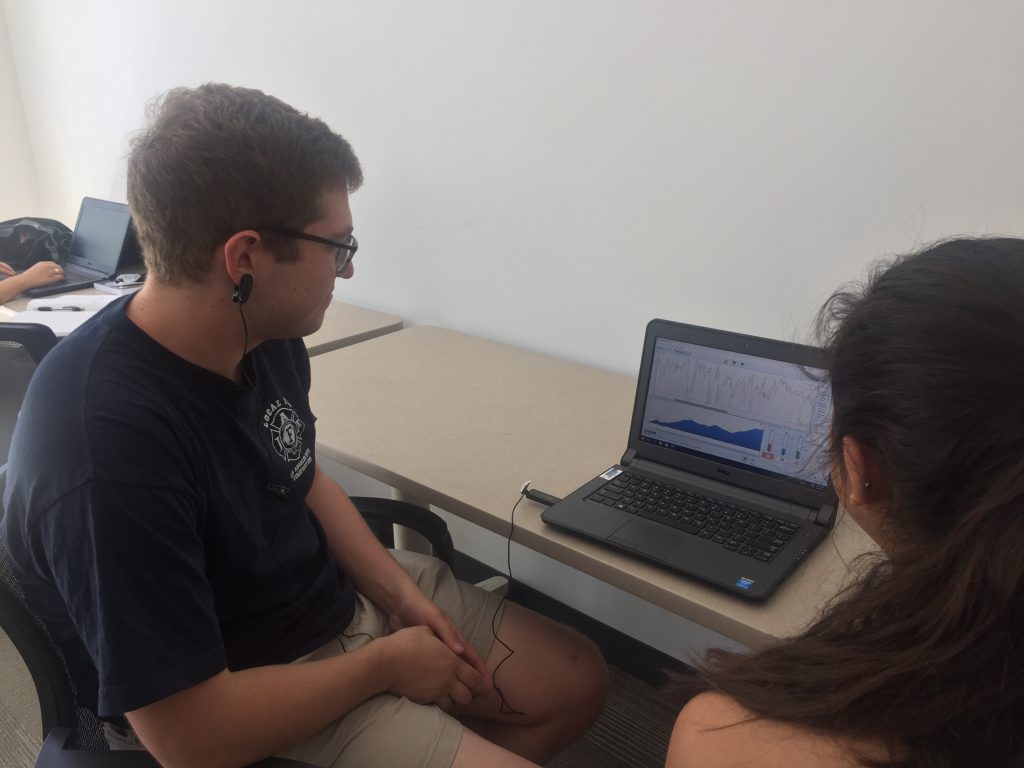
On Thursday, February 23, the School of Journalism and Mass Communications Advertising program was very proud. That’s because the advertising students received Best of Show, one Gold, five Silver and six Bronze awards at the annual Silicon Valley American Advertising Federation’s (AAF) ADDY Awards.
“Rewarding the best creative work of the previous year, the ADDY’s are judged by industry professionals who consider student and industry entries on an equal footing. receiving a Bronze, Silver or Gold is only topped by the coveted ADDY or Best of Show,” says Professor John Delacruz, Advertising.

February 23, 2017; San Jose, CA, USA; 2017 AAF-Silicon Valley Addy Awards held at Hapas Brewing Company in San Jose, CA. Mandatory Credit: Oliver Tapia – Milagro Marketing | Left to right: John Delacruz, Leah Viele-Verner, Sarah Weinman, Tim Hendrick
The event was held at Hapa’s Brewing in San Jose and was introduced by members of the AAF Board. SJSU professors Tim Hendrick, John Delacruz and lecturer David Ocampo, president, AAF as well as principal at Milagro Marketing introduced the show and presented awards to the winners. Creative direction for the event came from Professor Delacruz and was executed by students Arabela Espinoza and Talia Nakhjiri who worked from the theme of “Making your Mama Proud” across print, video, social media and event presentation.
Arabela Espinoza and Talia Nakhjiri won the only Gold award for an integrated campaign for Ventana Surfboards. “Ventana is a Santa Cruz based board manufacturer who designs, builds and sells surfboards crafted from up cycled wood,” says Professor Delacruz. “The wood typically comes from waste produced by other manufacturers in the area, Santa Cruz guitars for instance, or historic buildings under demolition.” Students Espinoza and Nakhjiri’s campaign was a new range of custom boards built with wood from the Western Flyer, John Steinbeck’s boat that was featured in his book, Log from the Sea of Cortez. “We are very proud of these students. This campaign was exquisitely art directed and crafted, won the JMC Blue Cow Award and awarded Best of Show!”
In addition, a number of non-profit campaigns received five Silver awards. Rebecca Ahrens and Eddie Toro received a Silver award for the Save Our Shores campaign. Natasha Mislang and Jackie Powers received one for a social media campaign for I Go Topless, a one-woman non-profit aiming to bring about cultural change around single use plastics, targeting plastic coffee cup lids specifically.
Culture was at the heart of Agency 66’s Royal Opera House Take-Over campaign. Silver awards were won by Agency 66, a student agency in the capstone Campaigns class consisting of Sean Taylor, Veronica Sandoval, Genna Carr, Rafael Cardenas and Derek Nelson. A team from the Dwight, Bentel and Hall student advertising and public relations agency led by Rebecca Ahrens and Josh Soyombo won a Silver award for an on-campus campaign positioning Acura in a new market space. Arabela Espinoza and Talia Nakhjiri’s campaign for Amnesty International, Feel My Injustice also was presented with a Silver award.

February 23, 2017; San Jose, CA, USA; 2017 AAF-Silicon Valley Addy Awards held at Hapas Brewing Company in San Jose, CA. Mandatory Credit: Oliver Tapia – Milagro Marketing | Kuntal Choudhary
The student teams also received six Bronze awards who responded to briefs as varied as Kuntal Choudhary and Amanda Tiet’s direction and advertising work for Gap Denim. Arabela Espinoza and Talia Nakhjiri received theirs for a non-profit initiative for Save Our Shores. This was the Dump the Bag campaign that was instrumental in California voter’s decision to retain the statewide plastic bag ban. These campaigns were integrated with an emphasis on social media. Other Bronze awards explored new approaches to media like Natasha Mislang’s series of six-second bumper ads for IKEA and Christine Huynh and Erika Nielsen’s mobile and radio campaign for Election – a non-partisan organization educating millennials on their voting choices. Kuntal Choudhary and Amanda Tiet won another Bronze for a rebranding and packaging solution for Barnum’s Crackers while Leah Viele-Verner received her Bronze award for “All the Right Moves” a campaign designed for a local realtor.

February 23, 2017; San Jose, CA, USA; 2017 AAF-Silicon Valley Addy Awards held at Hapas Brewing Company in San Jose, CA. Mandatory Credit: Oliver Tapia – Milagro Marketing | Left to right: John Delacruz, Tim Hendrick, David Ocampo
“We are pleased that SJSU’s advertising students are receiving recognition of their creative endeavors,” says Professor Delacruz. Last year there were also a record -breaking number of awards received, five Bronze, one Silver and one Gold. In 2013, there was one Bronze, one Silver award and in 2014, only one Silver award was given. “This year was a monumental year for our advertising students and we are very proud of their success.”
Addy Awards at a Glance:
Best of Show:
Arabela Espinoza and Talia Nakhjiri
Gold:
Arabela Espinoza and Talia Nakhjiri
Silver:
Arabela Espinoza and Talia Nakhjiri
Natasha Mislang and Jackie Powers
Rebecca Ahrens and Josh Soyombo
Rebecca Ahrens and Eddie Toro
Sean Taylor, Genna Carr, Veronica Sandoval, Derek Carr, Rafael Cardenas
Bronze:
Natasha Mislang
Leah Viele-Verner
Arabela Espinoza and Talia Nakhjiri
Kuntal Choudhary and Amanda Tiet
Kuntal Choudhary and Amanda Tiet
Christine Huynh and Erika Nielsen






